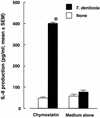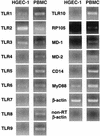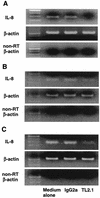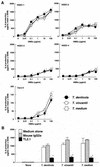Oral treponemes and their outer membrane extracts activate human gingival epithelial cells through toll-like receptor 2
- PMID: 12540550
- PMCID: PMC145376
- DOI: 10.1128/IAI.71.2.717-725.2003
Oral treponemes and their outer membrane extracts activate human gingival epithelial cells through toll-like receptor 2
Abstract
Oral treponemes are considered to be important in the development and progression of periodontal diseases. We investigated the mechanisms of recognition and activation of human gingival epithelial cells (HGEC) with the oral treponemes Treponema denticola, Treponema vincentii, and Treponema medium and their outer membrane extracts (OMEs). T. vincentii and T. medium but not T. denticola produced interleukin 8 (IL-8) in an HGEC culture. Further, all three treponemes induced IL-8 mRNA expression and NF-kappaB activation in HGEC. Among them, T. denticola especially exhibited trypsin- and chymotrypsin-like protease activities, and the addition of chymostatin, a chymotrypsin protease inhibitor, resulted in detectable IL-8 production by HGEC cultured with T. denticola. Additionally, IL-8 mRNA expression in HGEC cultured with the three treponemes and their OMEs was definitely inhibited by the mouse anti-human Toll-like receptor 2 (TLR2) monoclonal antibody TL2.1. These findings suggest that oral treponemes and their OMEs activate HGEC through TLR2.
Figures







References
-
- Alexopoulou, L., A. C. Holt, R. Medzhitov, and R. A. Flavell. 2001. Recognition of double-stranded RNA and activation of NF-kappaB by Toll-like receptor 3. Nature 413:732-738. - PubMed
-
- Aliprantis, A. O., R. B. Yang, M. R. Mark, S. Suggett, B. Devaux, J. D. Radolf, G. R. Klimpel, P. Godowski, and A. Zychlinsky. 1999. Cell activation and apoptosis by bacterial lipoproteins through Toll-like receptor-2. Science 285:736-739. - PubMed
-
- Bartold, P. M., L. J. Walsh, and A. S. Narayanan. 2000. Molecular and cell biology of the gingiva. Periodontology 24:28-55. - PubMed
Publication types
MeSH terms
Substances
LinkOut - more resources
Full Text Sources
Molecular Biology Databases

